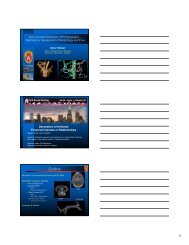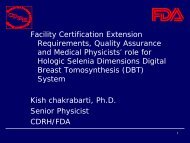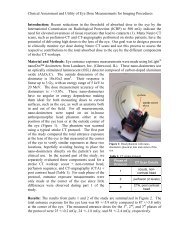Tolerances and Action Levels for IMRT QA Verification Measurements
Tolerances and Action Levels for IMRT QA Verification Measurements
Tolerances and Action Levels for IMRT QA Verification Measurements
Create successful ePaper yourself
Turn your PDF publications into a flip-book with our unique Google optimized e-Paper software.
<strong>Tolerances</strong> <strong>and</strong> <strong>Action</strong> <strong>Levels</strong><br />
<strong>for</strong> <strong>IMRT</strong> <strong>QA</strong> <strong>Verification</strong><br />
<strong>Measurements</strong><br />
Moyed Miften, PhD<br />
University of Colorado<br />
<strong>IMRT</strong> <strong>QA</strong> Survey<br />
Questions?<br />
Nelms <strong>and</strong> Simon, JACMP 8, 1-15 (2007)<br />
• What should be the delivery method <strong>for</strong><br />
<strong>IMRT</strong> <strong>QA</strong>?<br />
• What should be the criteria used ...<br />
composite %diff/DTA or Gamma?<br />
• How many of the points should pass this<br />
criteria … 90%, 95%, 98%?<br />
• What should be the tolerance levels <strong>and</strong><br />
action limits … 3%/3mm, 3%/5mm?<br />
1
Uncertainties- Planning<br />
Dose Calc<br />
Grid Size<br />
sizes/collimator<br />
backscatter<br />
MLC leaf end<br />
beam modeling<br />
<strong>IMRT</strong><br />
leaf/collimator<br />
transmission<br />
jaws/MLC<br />
penumbra<br />
modeling<br />
output factors <strong>for</strong> small<br />
fields <strong>and</strong> OAX profiles<br />
Uncertainties- Delivery<br />
MLC design<br />
(round leaf<br />
end, gap<br />
limitations,<br />
..etc)<br />
Beam stability<br />
(flatness, symmetry,<br />
segments with low MUs<br />
MLC leaf<br />
position errors<br />
<strong>IMRT</strong><br />
<strong>Action</strong> Limits (ALs)<br />
Isocenter<br />
MLC leaf<br />
acceleration/<br />
deceleration<br />
MLC tongue &<br />
groove<br />
• Quality measures (QMs) set a requirement<br />
<strong>for</strong> the per<strong>for</strong>mance of <strong>IMRT</strong> <strong>QA</strong><br />
• <strong>Action</strong> Limits<br />
degree to which the quality measures are<br />
allowed to vary<br />
thresholds <strong>for</strong> when an action is required<br />
based on clinical judgment<br />
• acceptability of a certain level of<br />
deviation from a QM<br />
2
Tolerance Limits (TLs)<br />
• TLs boundary within which a process is<br />
considered to be operating normally<br />
• <strong>Measurements</strong> outside of a TL provide a warning<br />
that a system is deviating<br />
– investigate to see if an issue can be identified<br />
<strong>and</strong> fixed<br />
• Intent fix issues be<strong>for</strong>e they become a<br />
clinical problem (i.e. data outside of ALs)<br />
Measurement Confidence Limit<br />
CL=|Mean Deviation|+1.96σ<br />
1.96 implies that 5%<br />
of the individual<br />
measurements may<br />
exceed the limit<br />
Pass Rate Confidence Limit<br />
CL=|100-Mean|+1.96σ<br />
1.96 implies that<br />
passing rates in<br />
excess of 100<br />
minus the CL may<br />
occur about 5% of<br />
the time<br />
3
What Should We Expect?<br />
Pass Rate < 90<br />
Do not treat!<br />
Pass Rate @AL<br />
90-95<br />
Pass Rate @ TL<br />
> 95%<br />
Proposed Values by Palta et al<br />
Confidence Limit: ∆ ∆ ∆ = = = | | Mean Deviation|+1.96σ<br />
ESTRO Booklet #9<br />
Palta et al, AAPM Summer School 593-612 (2003)<br />
• “Guidelines <strong>for</strong> the <strong>Verification</strong> of <strong>IMRT</strong>”<br />
• Summarized the experience of a number<br />
European institutions<br />
• Recommended <strong>for</strong> chamber measurements<br />
– 3% TLs<br />
– 5% ALs<br />
4
TG119 CLs <strong>and</strong> Passing Rates<br />
• High Dose Point in the PTV<br />
– CL of ±4.5%<br />
• Per Field <strong>Measurements</strong> (3%/3mm)<br />
– CL of ±7%<br />
– %passing γ > 93% ~95% of the time<br />
– 94% of tests fell within CL<br />
• Composite <strong>Measurements</strong> (3%/3mm)<br />
– CL of ±12%<br />
– %passing γ > 88% ~95% of the time<br />
– 93% of tests fell within CL<br />
Suggestions<br />
Ezzell et al, Med Phys 36, 5359 - 5373 (2009)<br />
• <strong>IMRT</strong> <strong>QA</strong> plan delivery<br />
–True composite OR Beam-by-Beam<br />
–Beam-by-beam composite is NOT<br />
recommended<br />
• Global normalization<br />
–Norm point in high dose small gradient<br />
• 10% low dose threshold<br />
• Absolute dose analysis<br />
%Diff/DTA Analysis<br />
• Pass ≥ 95% of the points within 3%/3mm<br />
(TLs) AND 100% of the points within<br />
5%/3mm (ALs)<br />
• Fail 90% of the points within 3%/3mm<br />
(TLs) OR any points outside of 5%/3mm<br />
(ALs)<br />
• Eval 90-95% of the points within<br />
3%/3mm<br />
5
γ Analysis Using 3%/3mm<br />
• Pass ≥ 95% of the points with γ < 1<br />
AND no point exceeding a max γ of 2.3<br />
(max dose diff of 7%)<br />
• Fail < 90% of the points with γ < 1 OR<br />
any point exceeding a max γ of 2.3<br />
• Eval: 90-95% of the points with γ < 1<br />
Steps to Check Marginal/Failed<br />
<strong>IMRT</strong> <strong>QA</strong><br />
• Phantom setup<br />
• Location of the global normalization point<br />
• <strong>QA</strong> plan generation <strong>and</strong> data transfer<br />
• Sensitivity <strong>and</strong> calibration of detector<br />
• Beam flatness, symmetry, <strong>and</strong> output<br />
• Beam stability when delivering low MU segs<br />
MLC <strong>and</strong> TPS<br />
• Leaf tolerances (speed, position,…etc)<br />
• TG effects <strong>and</strong> DLG <strong>for</strong> rounded-leaf ends<br />
• Leaf transmission<br />
• Tracking jaw positions<br />
• Total # of small segments in the plan<br />
• Calc grid size or the MC variance setting<br />
• Complexity of the intensity patterns<br />
6
Final Thoughts…<br />
• <strong>IMRT</strong> passing TLs & ALs may be refined<br />
• To include clinical site uncertainties<br />
• To include tolerances<br />
• To account <strong>for</strong> the design <strong>and</strong> age of the<br />
accelerator <strong>and</strong> equipment<br />
• Centers not able to meet suggested limits<br />
• Analyze distributions from a large # of cases<br />
• Derive limits to ensure > 95% of the time<br />
cases pass within the TLs<br />
• TG218 report is being drafted-- stay tuned<br />
Thank You<br />
CU Anschutz Medical Campus<br />
7


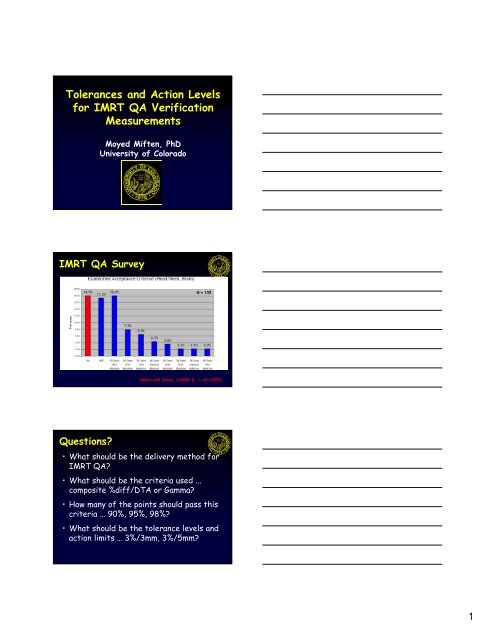


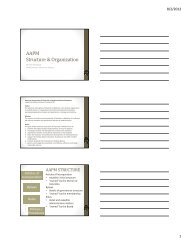
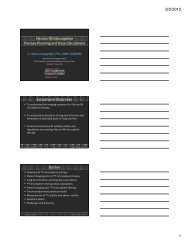

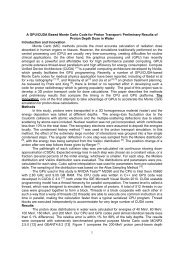
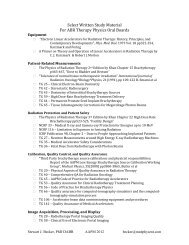
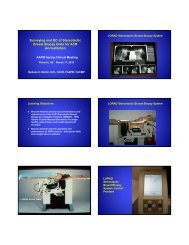
![SBRT&StereoscopicIGRT_2012 [Compatibility Mode]](https://img.yumpu.com/16889220/1/184x260/sbrtstereoscopicigrt-2012-compatibility-mode.jpg?quality=85)

